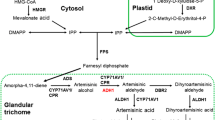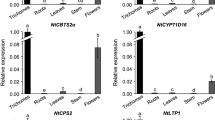Abstract
Amorpha-4,11-diene synthase (ADS) is the first key enzyme of artemisinin biosynthetic pathway in Artemisia annua L. In this study, the promoter region of the ADS gene has been cloned and used to demonstrate the expression of GUS reporter gene in both glandular trichomes of A. annua and non-glandular trichomes of Arabidopsis thaliana following homologous and heterologous expression of ADS promoter–GUS fusion. Subsequently, 5′ sequential deletion analysis of the ADS promoter revealed that a short sequence, −350 upstream of the transcription start site, was sufficient for trichome-specific expression in A. thaliana and that the region from −350 to −300 contained essential elements for this observed specificity. However, frequencies of transgenic A. thaliana plants displaying trichome-specific expressions varied between different lines, and all the lines with deleted fragments of the ADS promoter showed lower frequencies than the line with full-length ADS promoter. Most lines with deleted ADS promoter–GUS fusions showed GUS expressions in the guard cells of stomata as well, which was not observed in A. thaliana plants transformed with the full-length ADS promoter. GUS activities varied among different transgenic lines as well, both in transiently transformed Nicotiana benthamiana and stably transformed A. thaliana, with promoter–deletion lines exhibiting higher GUS activities than the full-length ADS promoter line.








Similar content being viewed by others
References
Abdin MZ, Israr M, Rehman RU, Jain SK (2003) Artemisinin, a novel antimalarial drug: biochemical and molecular approaches for enhanced production. Planta Med 69(4):289–299. doi:10.1055/s-2003-38871
Arsenault PR, Vail D, Wobbe KK, Erickson K, Weathers PJ (2010) Reproductive development modulates gene expression and metabolite levels with possible feedback inhibition of artemisinin in Artemisia annua. Plant Physiol 154(2):958–968. doi:10.1104/pp. 110.162552
Arsenault PR, Wobbe KK, Weathers PJ (2008) Recent advances in artemisinin production through heterologous expression. Curr Med Chem 15(27):2886–2896. doi:10.2174/092986708786242813
Avery MA, Chong WKM, Jenningswhite C (1992) Stereoselective total synthesis of (+)-artemisinin, the antimalarial constituent of Artemisia annua L. J Am Chem Soc 114(3):974–979. doi:10.1021/ja00029a028
Banyai W, Mii M, Supaibulwatana K (2011) Enhancement of artemisinin content and biomass in Artemisia annua by exogenous GA(3) treatment. Plant Growth Regul 63(1):45–54. doi:10.1007/s10725-010-9510-9
Brown GD, Liang G-Y, Sy L-K (2003) Terpenoids from the seeds of Artemisia annua. Phytochemistry 64(1):303–323. doi:10.1016/s0031-9422(03)00294-2
Chen D-H, Ye H-C, Li G-F (2000) Expression of a chimeric farnesyl diphosphate synthase gene in Artemisia annua L. transgenic plants via Agrobacterium tumefaciens-mediated transformation. Plant Sci 155(2):179–185. doi:10.1016/s0168-9452(00)00217-x
Duke SO, Vaughn KC, Croom EM Jr, Elsohly HN (1987) Artemisinin, a constituent of annual wormwood (Artemisia annua), is a selective phytotoxin. Weed Sci 35:499–505
Ennajdaoui H, Vachon G, Giacalone C, Besse I, Sallaud C, Herzog M, Tissier A (2010) Trichome specific expression of the tobacco (Nicotiana sylvestris) cembratrien-ol synthase genes is controlled by both activating and repressing cis-regions. Plant Mol Biol 73(6):673–685. doi:10.1007/s11103-010-9648-x
Ferreira JFS, Janick J (1996) Distribution of artemisinin in Artemisia annua. In: Progress in new crops. ASHS, Arlington, pp 579–584
Folkers U, Berger J, Hulskamp M (1997) Cell morphogenesis of trichomes in Arabidopsis: differential control of primary and secondary branching by branch initiation regulators and cell growth. Development 124(19):3779–3786
Galbiati M, Simoni L, Pavesi G, Cominelli E, Francia P, Vavasseur A, Nelson T, Bevan M, Tonelli C (2008) Gene trap lines identify Arabidopsis genes expressed in stomatal guard cells. Plant J 53(5):750–762. doi:10.1111/j.1365-313X.2007.03371.x
Gardner MJ, Baker AJ, Assie JM, Poethig RS, Haseloff JP, Webb AAR (2009) GAL4 GFP enhancer trap lines for analysis of stomatal guard cell development and gene expression. J Exp Bot 60(1):213–226. doi:10.1093/jxb/ern292
Gutierrez-Alcala G, Calo L, Gros F, Caissard JC, Gotor C, Romero LC (2005) A versatile promoter for the expression of proteins in glandular and non-glandular trichomes from a variety of plants. J Exp Bot 56(419):2487–2494. doi:10.1093/jxb/eri241
Higo K, Ugawa Y, Iwamoto M, Korenaga T (1999) Plant cis-acting regulatory DNA elements (PLACE) database: 1999. Nucleic Acids Res 27(1):297–300
Hsu CY, Creech RG, Jenkins JN, Ma DP (1999) Analysis of promoter activity of cotton lipid transfer protein gene LTP6 in transgenic tobacco plants. Plant Sci 143(1):63–70. doi:10.1016/s0168-9452(99)00026-6
Jefferson R (1987) Assaying chimeric genes in plants: the GUS gene fusion system. Plant Mol Biol Rep 5(4):387–405. doi:10.1007/BF02667740
Kapila J, DeRycke R, VanMontagu M, Angenon G (1997) An Agrobacterium-mediated transient gene expression system for intact leaves. Plant Sci 122(1):101–108. doi:10.1016/s0168-9452(96)04541-4
Kapoor R, Chaudhary V, Bhatnagar AK (2007) Effects of arbuscular mycorrhiza and phosphorus application on artemisinin concentration in Artemisia annua L. Mycorrhiza 17(7):581–587. doi:10.1007/s00572-007-0135-4
Kim SH, Chang YJ, Kim SU (2008) Tissue specificity and developmental pattern of amorpha-4,11-diene synthase (ADS) proved by ADS promoter-driven GUS expression in the heterologous plant, Arabidopsis thaliana. Planta Med 74(2):188–193. doi:10.1055/s-2008-1034276
Lescot M, Dehais P, Thijs G, Marchal K, Moreau Y, Van de Peer Y, Rouze P, Rombauts S (2002) PlantCARE, a database of plant cis-acting regulatory elements and a portal to tools for in silico analysis of promoter sequences. Nucleic Acids Res 30(1):325–327. doi:10.1093/nar/30.1.325
Liu CZ, Zhao Y, Wang YC (2006a) Artemisinin: current state and perspectives for biotechnological production of an antimalarial drug. Appl Microbiol Biotechnol 72(1):11–20. doi:10.1007/s00253-006-0452-0
Liu J, Xia KF, Zhu JC, Deng YG, Huang XL, Hu BL, Xu XP, Xu ZF (2006b) The nightshade proteinase inhibitor IIb gene is constitutively expressed in glandular trichomes. Plant Cell Physiol 47(9):1274–1284. doi:10.1093/pcp/pcj097
Ma DM, Pu GB, Lei CY, Ma LQ, Wang HH, Guo YW, Chen JL, Du ZG, Wang H, Li GF, Ye HC, Liu BY (2009) Isolation and characterization of AaWRKY1, an Artemisia annua transcription factor that regulates the amorpha-4,11-diene synthase gene, a key gene of artemisinin biosynthesis. Plant Cell Physiol 50(12):2146–2161. doi:10.1093/pcp/pcp149
Nguyen KT, Arsenault PR, Weathers PJ (2011) Trichomes plus roots plus ROS = artemisinin: regulating artemisinin biosynthesis in Artemisia annua L. Vitro Cell Dev Biol-Plant 47(3):329–338. doi:10.1007/s11627-011-9343-x
Ni SM, Meng LJ, Zhao J, Wang XC, Chen J (2008) Isolation and characterization of the trichome-specific AtTSG1 promoter from Arabidopsis thaliana. Plant Mol Biol Rep 26(4):263–276. doi:10.1007/s11105-008-0036-5
Olofsson L, Engstrom A, Lundgren A, Brodelius PE (2011) Relative expression of genes of terpene metabolism in different tissues of Artemisia annua L. BMC Plant Biol 11. doi:10.1186/1471-2229-11-45
Plesch G, Ehrhardt T, Mueller-Roeber B (2001) Involvement of TAAAG elements suggests a role for Dof transcription factors in guard cell-specific gene expression. Plant J 28(4):455–464. doi:10.1046/j.1365-313X.2001.01166.x
Prestridge DS (1991) SIGNAL SCAN: a computer program that scans DNA sequences for eukaryotic transcriptional elements. Computer Applications in the Biosciences : CABIOS 7(2):203–206
Pu GB, Ma DM, Chen JL, Ma LQ, Wang H, Li GF, Ye HC, Liu BY (2009) Salicylic acid activates artemisinin biosynthesis in Artemisia annua L. Plant Cell Reports 28(7):1127–1135. doi:10.1007/s00299-009-0713-3
Ro DK, Paradise EM, Ouellet M, Fisher KJ, Newman KL, Ndungu JM, Ho KA, Eachus RA, Ham TS, Kirby J, Chang MCY, Withers ST, Shiba Y, Sarpong R, Keasling JD (2006) Production of the antimalarial drug precursor artemisinic acid in engineered yeast. Nature 440(7086):940–943. doi:10.1038/nature04640
Rombauts S, Dehais P, Van Montagu M, Rouze P (1999) PlantCARE, a plant cis-acting regulatory element database. Nucleic Acids Res 27(1):295–296. doi:10.1093/nar/27.1.295
Sa G, Mi M, He-chun Y, Ben-ye L, Guo-feng L, Kang C (2001) Effects of ipt gene expression on the physiological and chemical characteristics of Artemisia annua L. Plant Sci 160(4):691–698. doi:10.1016/s0168-9452(00)00453-2
Tissier A (2012a) Glandular trichomes: what comes after expressed sequence tags? Plant J 70(1):51–68. doi:10.1111/j.1365-313X.2012.04913.x
Tissier A (2012b) Trichome specific expression: promoters and their applications. Transgenic Plants - Advances and Limitations. In Tech. doi:10.5772/32101
Wang EM, Gan SS, Wagner GJ (2002) Isolation and characterization of the CYP71D16 trichome-specific promoter from Nicotiana tabacum L. J Exp Bot 53(376):1891–1897. doi:10.1093/jxb/erf054
Wang H, Olofsson L, Lundgren A, Brodelius PE (2011) Trichome-specific expression of amorpha-4,11-diene synthase, a key enzyme of artemisinin biosynthesis in Artemisia annua L., as reported by a promoter–GUS fusion. Am J Plant Sci 2(4):619–628
Wang S, Wang JW, Yu N, Li CH, Luo B, Gou JY, Wang LJ, Chen XY (2004) Control of plant trichome development by a cotton fiber MYB gene. Plant Cell 16(9):2323–2334. doi:10.1105/tpc.104.024844
Wellems TE (2002) Plasmodium chloroquine resistance and the search for a replacement antimalarial drug. Science 298(5591):124–126. doi:10.1126/science.1078167
Werker E (2000) Trichome diversity and development. Advances in Botanical Research Incorporating Advances in Plant Pathology 31:1–35. doi:10.1016/s0065-2296(00)31005-9
Westfall PJ, Pitera DJ, Lenihan JR, Eng D, Woolard FX, Regentin R, Horning T, Tsuruta H, Melis DJ, Owens A, Fickes S, Diola D, Benjamin KR, Keasling JD, Leavell MD, McPhee DJ, Renninger NS, Newman JD, Paddon CJ (2012) Production of amorphadiene in yeast, and its conversion to dihydroartemisinic acid, precursor to the antimalarial agent artemisinin. Proc Natl Acad Sci USA 109(3):111–118. doi:10.1073/pnas.1110740109
World Health Organization (2011) World malaria report 2010. WHO, Geneva
Wu AM, Lv SY, Liu JY (2007) Functional analysis of a cotton glucuronosyltransferase promoter in transgenic tobaccos. Cell Res 17(2):174–183. doi:10.1038/sj.cr.7310119
Xu XX, Zhu J, Huang DZ, Zhou WS (1986) Total synthesis of arteannuin and deoxyarteannuin. Tetrahedron 42(3):819–828
Yamaguchi-Shinozaki K, Shinozaki K (1993) Arabidopsis DNA encoding two desiccation-responsive rd29 genes. Plant Physiol 101(3):1119–1120. doi:10.1104/pp. 101.3.1119
Yanagisawa S (2002) The Dof family of plant transcription factors. Trends Plant Sci 7(12):555–560. doi:10.1016/s1360-1385(02)02362-2
Yang RY, Zeng XM, Lu YY, Lu WJ, Feng LL, Yang XQ, Zeng QP (2010) Senescent leaves of Artemisia annua are one of the most active organs for overexpression of artemisinin biosynthesis responsible genes upon burst of singlet oxygen. Planta Med 76(7):734–742. doi:10.1055/s-0029-1240620
Yang YZ, Costa A, Leonhardt N, Siegel RS, Schroeder JI (2008) Isolation of a strong Arabidopsis guard cell promoter and its potential as a research tool. Plant Methods 4. doi:10.1186/1746-4811-4-6
Zeng QP, Qiu F, Yuan L (2008) Production of artemisinin by genetically-modified microbes. Biotechnol Lett 30(4):581–592. doi:10.1007/s10529-007-9596-y
Zhang L, Jing F, Li F, Li M, Wang Y, Wang G, Sun X, Tang K (2009) Development of transgenic Artemisia annua (Chinese wormwood) plants with an enhanced content of artemisinin, an effective anti-malarial drug, by hairpin-RNA-mediated gene silencing. Biotechnol Appl Biochem 52(3):199–207. doi:10.1042/ba20080068
Zhang XR, Henriques R, Lin SS, Niu QW, Chua NH (2006) Agrobacterium-mediated transformation of Arabidopsis thaliana using the floral dip method. Nat Protoc 1(2):641–646. doi:10.1038/nprot.2006.97
Acknowledgments
This work was funded by China “863” Program (grant no. 2011AA100605), China Transgenic Research Program (grant no. 2013ZX08002001-006), and Shanghai Leading Academic Discipline Project (Horticulture).
Author information
Authors and Affiliations
Corresponding author
Rights and permissions
About this article
Cite this article
Zhu, M., Zhang, F., Lv, Z. et al. Characterization of the Promoter of Artemisia annua Amorpha-4,11-diene Synthase (ADS) Gene Using Homologous and Heterologous Expression as well as Deletion Analysis. Plant Mol Biol Rep 32, 406–418 (2014). https://doi.org/10.1007/s11105-013-0656-2
Published:
Issue Date:
DOI: https://doi.org/10.1007/s11105-013-0656-2




